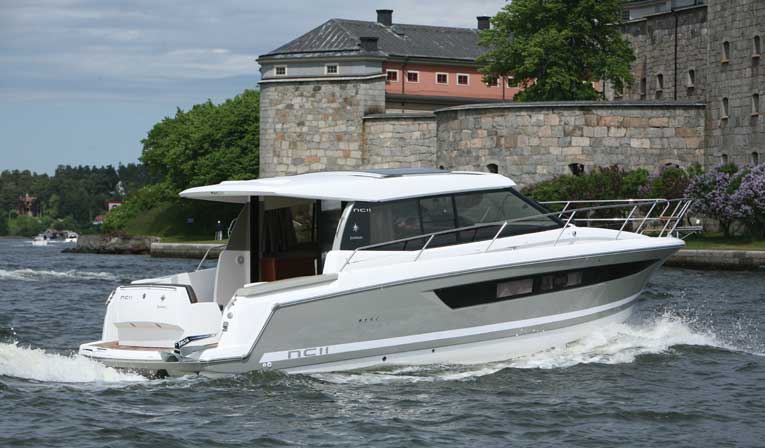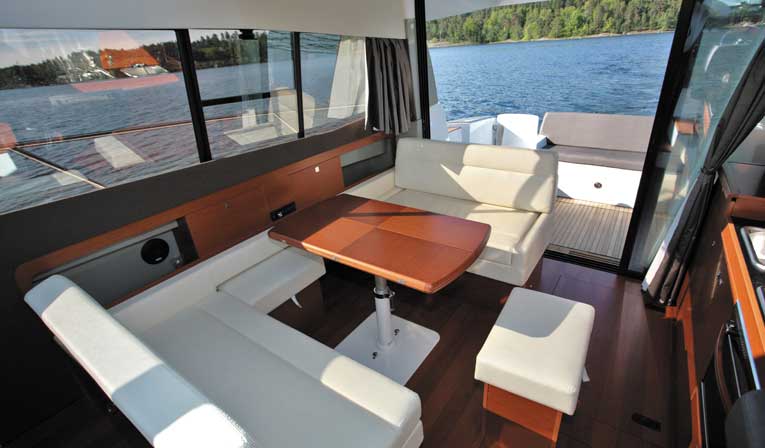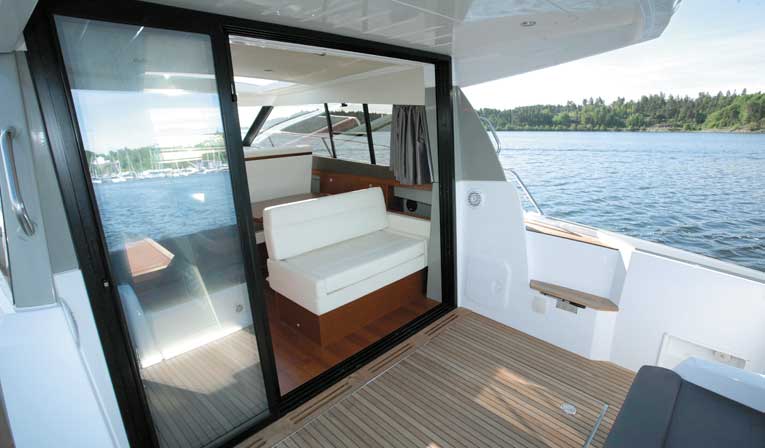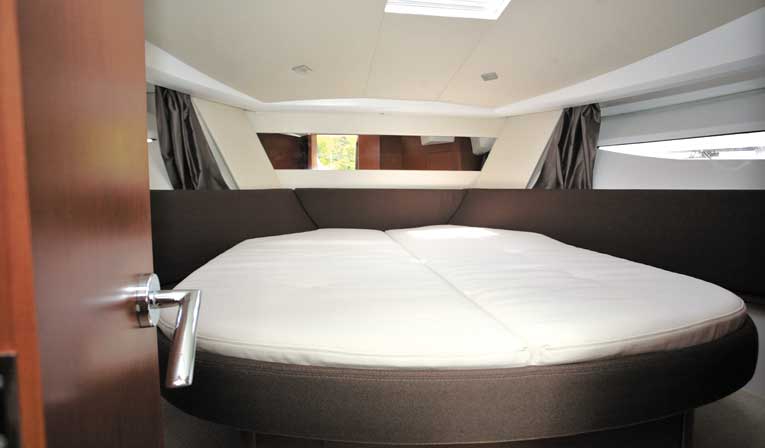A new concept in versatility.
by Gary Reich
People are using their boats in more ways than ever before — especially when it comes to powerboats. Ten years ago, most folks would have scoffed at the idea of toting along kayaks and stand-up paddleboards on their cruises. Today, the sight is relatively commonplace.
And, instead of trying to pack a dozen people into the cockpit come happy hour, folks are buying boats with open-concept floorplans that blend the outdoors with the interior, providing space for everyone to enjoy. As a result, many of today’s boatbuilders are designing boats with more utility and versatility.
The Jeanneau NC11 exhibits both of those qualities, with a bit of cleverness baked in. Perhaps it’s fitting that the “NC” in NC11 stands for “New Concept.”
“The boat is designed for folks who might enjoy a boat that’s got a mix of different themes,” says Jeanneau America president Nicolas Harvey, who accompanied me on the review. “It’s sort of a shape shifter; in some ways it has trawler qualities, while in others it resembles an express boat. In other ways, the boat is very adaptable and utilitarian. But, as you’ll see, it’s still elegant and luxurious.”
With that, we left the brokerage office and headed down to the marina dock. As luck would have it, I had the pleasure of running this boat on my home waters of the Chesapeake Bay.
Shape shifter
At first glance, the NC11 has a very angled and serious look, which suits this versatile boat’s purpose well. Look closer and you’ll see some DNA from Jeanneau’s luxury motoryacht division, Prestige Yachts, in the NC11’s lines. My test boat had a tasteful bronze and white color scheme and was smothered in beautiful teak planking on the aft and side decks.
Stepping onto the aft deck, you see that this boat is all about enjoying the outdoors. The centerpiece of the aft cockpit is a wide bench with lots of versatility. In its usual position, the bench sits three and separates the sprawling swim platform from the aft cockpit; but pull a couple of pins, slide it forward, and the swim platform real estate increases by at least a third. Slide the whole thing back again, and you’ve expanded the space in the cockpit for entertaining. If that wasn’t enough, you can also turn the versatile unit into a huge sunpad. There’s also plenty of stowage underneath: it’s big enough for paddles, PFDs, or even a small outboard.
The NC11’s shape-shifting qualities continue into the main salon. Here, a 4-piece sliding door separates the area from the aft cockpit. Slide the panels open to port or starboard, and it creates a single-level indoor/outdoor living space. Want to open things up even more? Just press a button over the port helm station, and the cabin-wide aluminum and glass sunroof peels back to open up nearly a third of the cabin top space to the sky. Closed, it completely seals out rain and any spray you might encounter.
The main salon’s starboard dinette is exceptionally innovative. Its forward bench flips up to create companion seating across from the helm and just behind the one-piece windshield. The dinette’s aft bench flips back to create additional seating in the aft cockpit. The dinette’s table is easily removable and can be placed in the aft cockpit to create an outdoor dining space for six people. Two upholstered stools can be moved around to enhance seating configurations, and the dinette can also be converted to sleeping space. Clever, right?
The galley across from the dinette is nicely laid out with a stainless steel sink and a two-burner electric stove, both hidden under two panels that lift up with gas-assist struts. A microwave is just under the stove. A gas cook top and a separate gas oven are an option, and I’d recommend it for more serious onboard chefs. Counter space is fairly limited, as is stowage space for cookware and dining ware, but Jeanneau has included a nifty “cellar” under the cabin sole, which has pullout drawers and plenty of room for stowing sundries and dry goods. It’s not completely easy to access, but Harvey tells me owners have made all sorts of customizations to this area to suit their cruising needs.
All the way forward, and down three steps, is a common landing. Forward is the master stateroom, which has a queen-size island berth. The guest stateroom is to starboard with two single berths, and to port is the shared enclosed head/shower. There’s plenty of light below, thanks to hullside windows and an overhead hatch in the master stateroom. Though it’s likely to feel a little cramped for those of us who aren’t as… ahem… flexible as we used to be, the guest mid-cabin stateroom has enough headroom for getting dressed.
All in all, the NC11’s interior feels rich, luxurious and comfortable through and through. Now, let’s go for a ride.
Power plant
My NC11 test craft was fitted with the standard power plant package: a pair of 200hp Volvo Penta D3 turbo diesels, mated to DPS Duoprop sterndrives. A 330hp D6 turbo diesel with DPR Duoprop sterndrive is available as an option, as is Volvo Penta’s joystick steering system, which my test craft had. The engines are installed neatly below the aft cockpit and are easily accessible through a large hatch with gas-assist struts. Access space for routine fluid and filter checks is excellent, as is the accessibility to other mechanical systems that live there, such as batteries, battery chargers and generator, etc. Time to get underway.
Motoring out toward the Chesapeake Bay through the marina’s no-wake zone, even with the portside door next to the helm and aft sliding doors open, the cabin and aft deck spaces are extremely quiet. In fact, Jeanneau’s own testing shows only between 58 dBA and 78 dBA at the helm station throughout the engines’ rpm range, and I loosely verified those figures with my very unscientific smartphone decibel meter. At the helm, I find the controls all very easy to read and reach, and I particularly like the sliding door that allows easy access to the portside deck from the portside helm; it vastly enhances ventilation for the skipper.
While underway, with the Chesapeake Bay Bridge as a beautiful backdrop, I mash down the throttles. While there’s a bit of the usual turbo lag, the D3s spool up quickly and provide notably good acceleration. After some drive trim adjustments, I coax the NC11 up to around 30 knots at 4,000 rpm. Though I was having some difficulty getting the fuel flow aspects of the engine displays, Jeanneau’s testing shows a fuel consumption of around 20 gallons per hour at this speed. Most folks will want to cruise in the 14-18 mph range, where the best fuel economy lies between two and three gallons per hour.
There wasn’t a ton of chop on the Chesapeake the day I ran the NC11, but I quickly dealt with the situation by spinning the NC11 in a series of high-speed figure eight patterns. This gave me a chance to see how nimble the NC11 is, and also allowed me to stir up some fine waves to smash into. Concerning the nimble aspect of that exercise, the NC11 is easy to spin around and tracks extremely well, cornering with ease. As far as the 2- to 3- foot chop I created goes, the NC11 pushed through those waves quite well at full speed.
So, should you consider this latest creation from French builder Jeanneau? If your boating adventures involve all sorts of activities — from cruising, to anchoring out, to entertaining friends and family — then the NC11 should be on the top of your list. It’s a new concept with a lot of versatility.
Specifications
- LOA: 36’6″
- Beam: 12’3″
- Draft:
- Weight: 13,062 lbs.
- Fuel Capacity: 190 gals.
- Water Capacity: 66 gals.
- Power: T-Volvo Penta 200hp D3 diesels
- Price: $314,800
- Website: jeanneau.com
Photo Courtesy of Jeanneau
Photo Courtesy of Jeanneau
Photo Courtesy of Jeanneau






